illustration
- A design or picture
in a book, magazine or other print or electronic
medium that explains the
text or shows what happens in a story.
Examples:

France, Troyes, Dance of Death, 16th century, incunabulum,
illustrated with hand-colored woodcuts,
Saxon State Library, Dresden, Germany. Based on a fourteenth-century
morality poem by an unidentifiable author, the Dance of Death
evolved into a set of illustrated
verses depicting a dialogue
between Death and people of all social ranks. The theme
was very popular in 15th and 16th century Christian Europe, reminding
the living that rank and station in life were meaningless in
the face of death. The illustrations show representations
of ecclesiastical and secular society being carried off by Death.
The pages displayed here show the Pope, the Emperor, a cardinal,
and a king. See dance
and vanitas.
Andrea Palladio (Andrea di Pietro della
Gondola) (Italian, 1508-1580), author; Venice: Domenico de'Franceschi,
1570 (4 parts in one volume),  publisher,
I Quattro Libri dell'architettura di Andrea Palladio...,
1570 (4 parts in one volume), printed book; 128 p. : ill., maps
; 12 cm, Metropolitan Museum of Art, NY. See Palladian.
publisher,
I Quattro Libri dell'architettura di Andrea Palladio...,
1570 (4 parts in one volume), printed book; 128 p. : ill., maps
; 12 cm, Metropolitan Museum of Art, NY. See Palladian.
Illustrated:
title page of Andrea Palladio's I Quattro Libri dell'architettura
and engraved portrait of Palladio from the frontispiece.
Denis Diderot (French, 1713-1784), author;
Jean d'Alembert  (French,
1717-1783), author; Paris: Briasson, 1751-1765, publisher; Neufchastel
: S. Faulche & cie., Vols. 8-17 published, Encyclopedie, ou Dictionnaire Raisonne des Sciences,
des Arts et des Metiers, 1751-1765, printed book; 17
v. : fold. tab. ; 40 cm, Metropolitan Museum of Art, NY.
(French,
1717-1783), author; Paris: Briasson, 1751-1765, publisher; Neufchastel
: S. Faulche & cie., Vols. 8-17 published, Encyclopedie, ou Dictionnaire Raisonne des Sciences,
des Arts et des Metiers, 1751-1765, printed book; 17
v. : fold. tab. ; 40 cm, Metropolitan Museum of Art, NY.
Illustrated:
Plates, Volume 8. Plate 1- "Relieur". The procedures
for binding a book from the Encyclopedie.
Sir Thomas  Malory
(British, 15th c.), author; Aubrey Beardsley (British, 1872-1898),
illustrator; London: J. M. Dent and Co., 1893, Publisher, Morte d'Arthur, 1893, printed book; 12
pts. : ill. , pl. ; 26 cm, Metropolitan Museum of Art, NY.
Malory
(British, 15th c.), author; Aubrey Beardsley (British, 1872-1898),
illustrator; London: J. M. Dent and Co., 1893, Publisher, Morte d'Arthur, 1893, printed book; 12
pts. : ill. , pl. ; 26 cm, Metropolitan Museum of Art, NY.
Illustrated:
Aubrey Beardsley's design for the printed paper wrapper from
Part I. See aestheticism
and fin de siècle.
![]()

William Blake (British, 1757-1827), from
Songs of Innocence and of Experience/'Songs of Innocence': Title-Page, 1789,
reprinted 1831 or later, relief etching on paper,
image 12.0 x 6.4 cm, Tate Gallery, London. See Romanticism.

William Blake, Pity, c. 1795, color print finished in
ink and watercolor on paper,
42.5 x 53.9 cm, Tate Gallery, London. The subject is partly drawn
from Shakespeare's play Macbeth.

William Blake, from Illustrations to `The
Book of Job' / Satan before the Throne of God, 1825,
reprinted 1874, Tate Gallery, London.
Sir John Tenniel (English, 1820-1914).
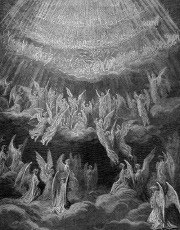
Gustave Doré (French, 1832-1883),
Glory
be to the Father . . . , c. 1861, wood
engraving, illustration
for Dante's Divine Comedy, The Paradiso, Canto
XXVII.
Walter Crane (English, 1845-1915).

Randolph Caldecott (English, 1846-1886),
Good-bye, Baby Bunting, engraved by Edmund Evans, image 15.9
x 18.4 cm, Tate Gallery, London. Caldecott's illustrations for
children's books have been so highly regarded that the annual
award -- the Caldecott Medal -- for best children's book illustration
was named after him.
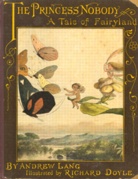
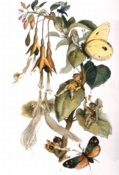
Richard Doyle, illustrator, cover of Andrew Lang's The
Princess Nobody, A Tale of Fairyland,
1884, published by E.P. Dutton & Co., New
York.
Doyle's frontispiece for The
Princess Nobody. See frontispiece.
Edward Austin Abbey (American, 1852-1911).

Howard Pyle (American, 1853-1911), page decoration for the "Seven O'Clock"
chapter heading of his book, The Wonder Clock, 1887,
ink on paper.
Howard Pyle founded the "Brandywine School" of illustration. Among
his students were N.C. Wyeth, Maxfield Parrish, Violet Oakley,
Jessie Willcox Smith and Frank Schoonover. See three
fairy tales illustrated and written by Howard Pyle.
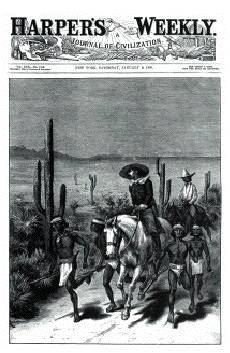
Frederic Remington (American, 1861-1909),
The Apache War -- Indian Scouts on Geronimo's Trail, as
published on the first page of Harper's Weekly, January 9, 1886.
Remington's drawing
was copied by the maker of this wood
engraving. See nocturne.
Jessie Willcox Smith (American, 1863-1935).

Helen Beatrix Potter (English, 1866-1943),
from Illustrations for "The Tailor of Gloucester",
Frontispiece: The Tailor Mouse, c. 1902, pen
and ink and watercolor on paper,
11.1 x 9.2 cm, Tate Gallery, London. See frontispiece.

Helen Beatrix Potter, from Illustrations
for "The Tailor of Gloucester", Simpkin in the Snowy Street, c. 1902,
pen and ink
and watercolor
on paper, support: 11.1 x 9.2 cm,
Tate Gallery, London.

Helen Beatrix Potter, from Illustrations
for "The Tailor of Gloucester", The Mice Sewing the Mayor's Coat, c.
1902, pen and ink
and watercolor
on paper, 9.2 x 11.1 cm, Tate Gallery,
London.
Charles Dana Gibson (American, 1867-1944).

Arthur Rackham (English, 1867-1939), The Dance in Cupid's Alley, 1904, pen and ink
and watercolor
on paper, 32.4 x 59.7 cm, Tate
Gallery, London.
Maxfield Parrish (American, 1870-1966). See kitsch.
Charles Robinson (American, 1870-1937).
Elizabeth Shippen Green (American, 1871-1954).
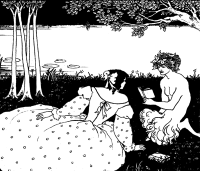
Aubrey Beardsley (English, 1872-1898),
design for the cover of the prospectus for The
Yellow Book, Volume I (April
1894), and an unused design for the cover of The
Yellow Book, Volume V. See
aestheticism and fin
de siècle.

Aubrey Beardsley, Messalina and her Companion, 1895, pencil, ink
wash and watercolor on paper,
27.9 x 17.8 cm, Tate Gallery, London.
![]()
Aubrey Beardsley, The Dream, 1896, pen
and black ink, J. Paul Getty Museum, Malibu,
CA.
J. C. Leyendecker (American, 1874-1951).

Ivan Bilibin (Russian, 1876-1942), Ivan the Tsar's Son and the Firebird,
1899, illustration to the fairy-tale "Ivan the Tsar's Son,
the Firebird, and the Grey Wolf." See Russian
art.
Ivan Bilibin, The Merchants Visit Tsar Saltan, 1905, illustration to "The Tale of Tsar Saltan" by Pushkin.

James Montgomery Flagg (American, 1877-1960),
I Want You for U.S. Army, 1917, chromolithograph,
39 1/2 x 29 1/8 inches (100.4 x 73.8 cm), National Museum of
American Art. Flagg's version of Uncle Sam is a self-portrait.
Used for recruitment during World War I and again during World
War II, his popular poster demonstrates the commanding effectiveness
of a strong design and simple
message. See poster.

George Bellows (American, 1882-1925), The Drunk,
c. 1924, lithograph,
second state, printed
by Bolton Brown, published as an illustration for Mabel Potter
Daggett, "Why We Prohibit," in Good Houskeeping,
May 1924, Library of Congress, Washington, DC.
Edmund Dulac (French, 1882-1953).
![]()
N. C. (Newell Convers) Wyeth (American, 1882-1945),
Bronco Buster, 1907, oil
on canvas, 41 1/2 x 28
1/8 inches, Minneapolis Institute of Arts. This picture was commissioned
for ads for "Cream of Wheat" breakfast cereal. Newell
Convers Wyeth was best known as "N.C.," and was the
father of painter Andrew Wyeth (American, 1917-) and Henriette,
and the grandfather of painter James Wyeth. See portrait and realism.
N. C. Wyeth, "One more step, Mr. Hands," said I, "and I'll blow your brains out", 1911, illustration for Treasure Island by Robert Louis Stevenson, Scribner's first edition (1911), New Britain Museum of Art, CT.
Edward Julius Detmold (English, 1883-1957).
Kay Nielsen (Danish and American, 1886-1957).
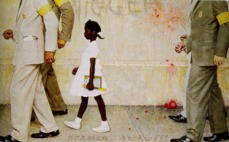
Norman Rockwell (American, 1894-1978), The
Problem We All Live With, published in Look, January
14, 1964, oil on canvas,
Arts International, Chicago, IL. See narrative
art and Realism.
Also see clip art, frontispiece,
graphic arts, graphic
design, iconography,
illustrate,
illustrator,
page, poster, and tip.
https://inform.quest/_art